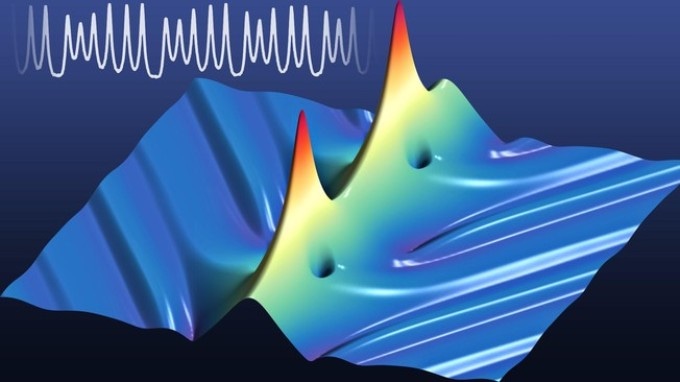Oct 6 2017
A dissipative soliton, in optics, comprises of a light pulse that is capable of traveling without deformation.
This is obtained from a balance between two counterbalancing effects: on one hand, the dispersion of the propagation medium inclines to lengthen the pulse duration, but this is offset by the Kerr-nonlinearity, which is responsible for compressing it again, while on the other hand, the propagation losses, which incline to weaken the pulse, are counterbalanced by the gain that is provided by a laser.
These solitons are trapped in an optical cavity by EPFL Researchers, such that they "go round in circles", which indeed helps in simplifying their study. Additionally, these cavity solitons have in recent times attracted immense interest as they can produce ultra-fast trains of light pulses, discovering applications in spectroscopy or frequency metrology as they constitute optical frequency combs.
 Numerical simulation of the evolution of a breathing soliton and measured oscillations. © Erwan Lucas
Numerical simulation of the evolution of a breathing soliton and measured oscillations. © Erwan Lucas
This double compensation is degraded under specific operating conditions and the soliton is destabilized and starts to oscillate – Scientists refer to it as breathing – prior to collapsing and then vanishing, due to a tipping point in the equilibriums of the system.
This type of instability is considered to be characteristic of non-linear dynamical systems and has been also observed in the dynamics of lasers close to threshold, and even the evolution of species populations (Lotka-Volterra prey-predator model) or in the climate. In all of these cases, early warning signs, such as the slowing of the oscillations, to a certain extent enable predicting a critical transition of the system (such as the extinction of a species).
The advantage of the optical system refers to the fact that the time scales are extremely fast and a huge number of realizations can be analyzed. Professor Kippenberg's team recently enhanced the control methods of the optical system allowing experiments to be performed under well-defined parameters.
In this latest work, Erwan Lucas and his colleagues deterministically induce soliton breathing and then directly observe the spatio-temporal dynamics. Their study focuses on experimentally validating the predictions of numerical models, particularly on the significant slowing down of the system and its progress towards chaos.
“It is truly fascinating to see that a seemingly simple system can exhibit such complex dynamics! " explain the team members. As the soliton is increasingly unstable, the amplitude of the oscillations also increases and their frequency decreases, while the oscillation pattern becomes more and more complex and incoherent. The study further established the fact that several solitons are capable of interacting and synchronizing their oscillations.
These observations offer experimental validation of non-linear optical models in the unstable case. The methods developed by the scientists also provide a variety of diagnoses in order to prevent these solitons instabilities and guarantee a steady operation of the frequency combs.